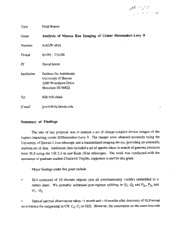
NASA Technical Reports Server (NTRS) 19990025447: Analysis of Mauna Kea Imaging of Comet Shoemaker-Levy 9 PDF
Preview NASA Technical Reports Server (NTRS) 19990025447: Analysis of Mauna Kea Imaging of Comet Shoemaker-Levy 9
) .. ¢" l Type Final Report Grant Analysis of Mauna Kea Imaging of Comet Shoemaker-Levy 9 Number NAGW 4816 Period 8/1/95 - 7/31/98 PI David Jewitt Institution Institute for Astronomy University of Hawaii 2680 Woodlawn Drive Honolulu HI 96822 Tel 808-956-6664 E-mail jewitt@ ifa.hawaii.edu Summary of Findings The aim of this proposal was to analyse a set of charge-coupled device images of the Jupiter-impacting comet D/Shoemaker-Levy 9. The images were obtained primarily using the University of Hawaii 2.2-m telescope and a standardized imaging device, providing an unusually uniform set of data. Additional data included a set of spectra taken in search of gaseous emission from SL9 using the UH 2.2-m and Keck 10-m telescopes. The work was conducted with the assistance of graduate student Chadwick Trujillo, supported in part by this grant. Major findings under this grant include SL9 consisted of 25 discrete objects (not all simultaneously visible) embedded in a debris sheet. We probably witnessed post-rupture splitting in Q1, Q2 and P2a, P2b and G1, G2. • Optical spectral observations taken ~ 1month and - 10 months after discovery of SL9 reveal no evidence for outgassing in CN, C2, C3or O[I]. However, the constraints on the mass loss rate Page 2 are weak - mass loss rates 1000 kg S-1 would have escaped detection in our data. However, at 5 AU, cometary outgassing is expected to be very weak. Therefore, the spectral evidence cannot be used to preclude the cometary nature of SL9. • The overall morphology of SL9 evolved on timescales of months. The length of the train of nuclei increased steadily with time, as expected from the dynamics of breakup in the Jovian environment. We passed astrometry of the components to D. Yeomans, Z. Sekanina and B. Marsden in nearly real-time, so as to facilitate the effort to identify the nature of the break-up and to predict the impact times in the atmosphere of Jupiter. The fine seeing and quality of the instrumentation employed allowed us to measure sub-arcsecond positions at a time when most other observers were able only to measure the "center of mass" of the train. • Individual components of SL9 also evolved, both photometrically and morphologically. Different components faded at different rates. Remarkably, the fading rate was found to be correlated with the positional offset of component from the median line of the trail (Figure 1). 4.5 L 4.0 m 3.5 3.0 2.5 2.0 tL 1.5 [ 1.0 _ , L ] I , , , I I L _ I I , I , , I , , * t 0.5 0 -1 -2 -3 -' Offset from Median Line [arcsec] Figure 1- Fading rate of each component of SL9 measured as a function of positional offset from the median line. One interpretation of this observation is that the smaller (shorter lived) fragments of the SL9 precursor were ejected faster than the large (long-lived) fragments.
